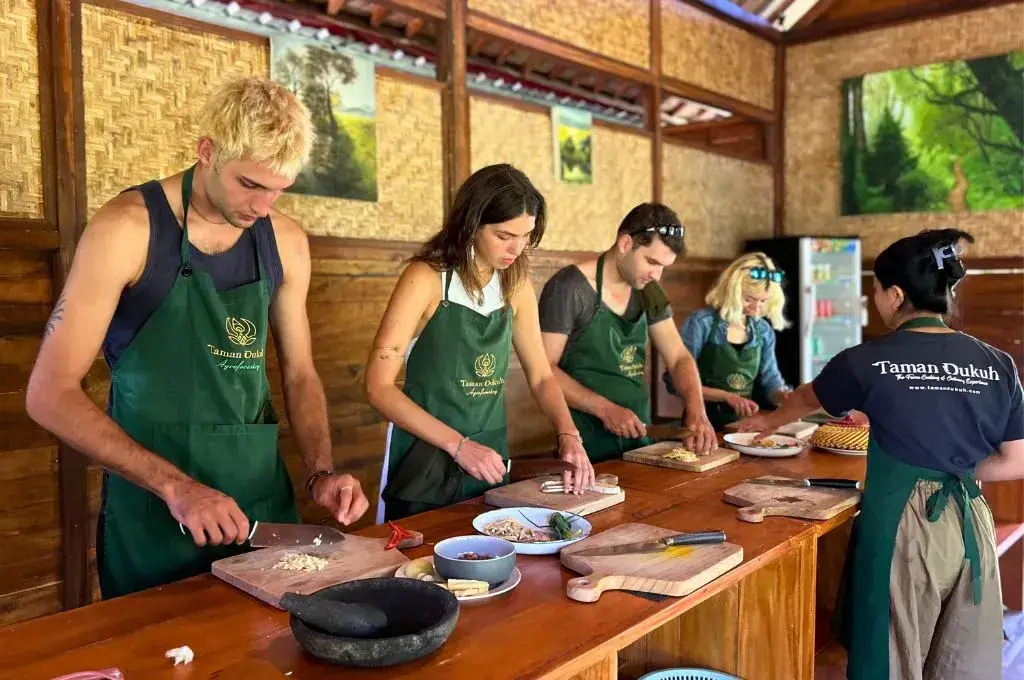The Soulful Art of Balinese Cooking techniques
So, you’re captivated by the “delicious and super aromatic” world of traditional Balinese dishes and curious about how those incredible flavors are achieved?
Beyond the amazing Balinese spices and fresh ingredients, it’s the array of time-honored Balinese cooking techniques that truly unlocks their magic and transforms them into culinary masterpieces.
At Taman Dukuh, our “friendly, funny, and passionate” Balinese cooking instructors believe that understanding these methods is absolutely key to appreciating and successfully recreating authentic Balinese cuisine. These aren’t just mechanical steps in a recipe; they are an art form, a “hands-on” tradition passed down through generations. Each Balinese culinary technique is purposefully designed to coax out the most vibrant flavors, create delightful textures, and honor the ingredients.
Get ready to explore the fundamental Balinese cooking methods that will empower you to bring the true taste of Bali into your own kitchen. Learning these techniques in our Ubud cooking classes is often described by our guests as a “highlight of their trip” and an “unforgettable cultural experience”!
Core Balinese Cooking Techniques: Your Path to Flavor Mastery & Authentic Bali Food Preparation
Authentic Balinese cuisine utilizes a wonderful and diverse range of methods, from the delicate art of spice grinding to the robust flavors achieved through open-flame grilling. These traditional Balinese cooking methods are the cornerstone of creating genuine island dishes. Here are some of the fundamental techniques you’ll encounter and even try your hand at in our engaging Balinese cooking workshops in Ubud:
1. Merajang (Meticulous Fine Chopping & Slicing – The Foundation of Flavor)
This is where Balinese culinary precision truly shines, a skill honed over generations! Merajang refers to the art of very finely chopping or slicing ingredients, especially the diverse components of the all-important bumbu (Balinese spice pastes). This isn’t just about making things small; it’s about achieving a consistent, fine texture.
Why is this so crucial? A uniform, fine chop achieved with a traditional blakas (Balinese cleaver) or tiuk (smaller knife) ensures that all the flavors from the various Balinese spices meld together perfectly. It also allows them to cook evenly when sautéed, releasing their full aromatic potential without any single ingredient overpowering others.
Our chefs will show you how this careful preparation is the first essential step to unlocking those complex, layered Balinese flavors that make dishes like Lawar so uniquely delicious and integral to traditional Bali food preparation.
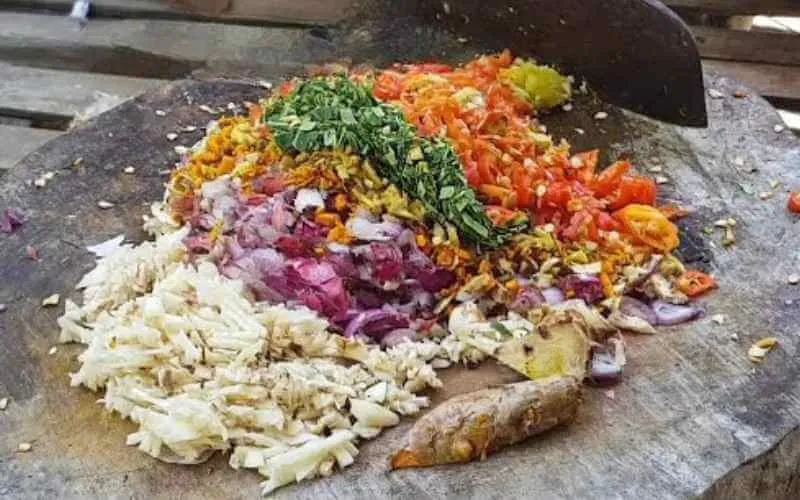
Merajang – finely chopping fresh ingredients for the perfect Balinese spice paste (bumbu), a core Balinese cooking skill.2. Ngulek / Ngerus (Grinding & Pounding with Mortar & Pestle – Releasing True Aroma)
Here’s where the true magic of bumbu making happens, a technique absolutely central to authentic Balinese food preparation! Ngulek (or ngerus) is the traditional Balinese technique of grinding and pounding spices using a stone mortar (cobek) and pestle (ulekan or batu base). These are not just any tools; they are essential Balinese cooking utensils, often passed down.
What’s the difference? This rhythmic pounding and grinding action is believed to bruise and crush the fresh Balinese ingredients in a way that releases their essential oils, deepens their fragrances, and melds their nuanced flavors far more effectively and authentically than a modern electric food processor. It creates a spice paste with unparalleled depth, a slightly coarser texture, and an aroma that is quintessentially Balinese.
Getting “hands-on” with a cobek and ulekan, learning the right pressure and motion, is a “fun and engaging” part of our Ubud cooking classes that our guests find incredibly satisfying. It truly connects them to the ancient heart of Balinese cooking and the secrets of how to cook Balinese food.
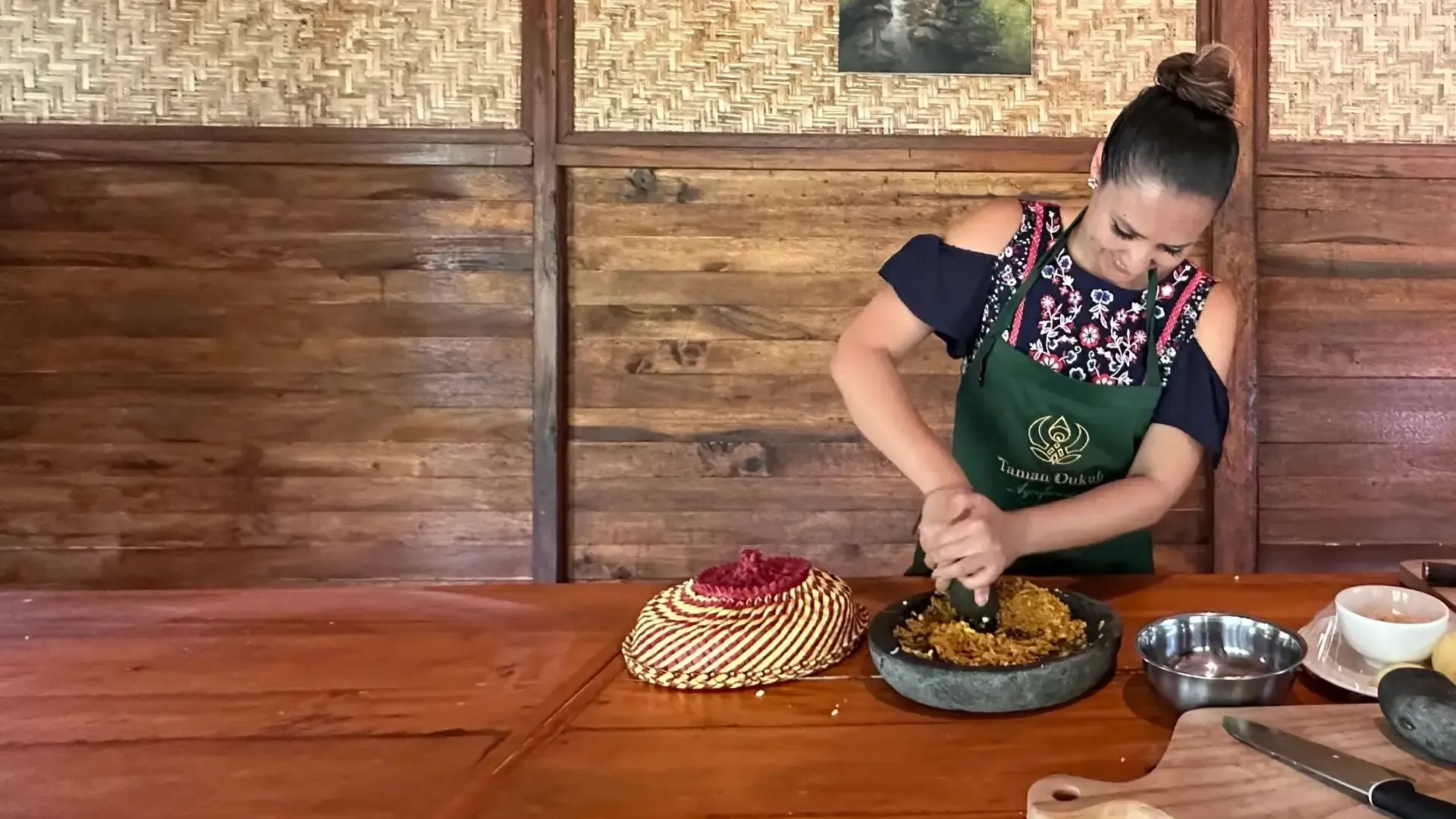
Ngulek – the art of grinding spices in a stone cobek to release their full aromatic power for authentic Balinese bumbu, a key Balinese culinary technique.3. Menumis / Nyambel / Nyangluh (Sautéing/Toasting – Building the Aromatic Flavor Base)
Once your bumbu is perfectly ground, menumis (general sautéing), nyambel (specifically, preparing sambal or sautéing a spice paste for a dish), or nyangluh / menyanyah (dry-frying/toasting spices before grinding) are the next crucial steps in many Balinese recipes.
The spice paste is gently fried in a little oil (for menumis/nyambel), often in a wajan (wok), until intensely fragrant (harum) and slightly darkened. For nyangluh, whole spices like coriander seeds or candlenuts are toasted in a dry pan to awaken their aromas before being ground.
This cooking process is vital. It melds and deepens the individual flavors of the spices, mellows any raw notes from ingredients like garlic or shallots, and creates an intensely aromatic foundation for Balinese curries (kari), rich stews, vibrant vegetable dishes (jukut), and complex sambals. The aroma that fills our kitchen at this stage is simply divine and a hallmark of truly authentic Balinese cooking!
4. Menggoreng (Frying – For Crispiness & Delightful Textures in Balinese Food)
Who doesn’t love a bit of crispy goodness? Menggoreng, or frying (encompassing both shallow and deep-frying), is a popular Balinese cooking method used for a delightful variety of Balinese foods. Think of crunchy krupuk (crackers that puff up when fried), savory fritters like bergedel jagung (corn fritters – a vegan Balinese cooking favorite!), crispy fried chicken (ayam goreng bumbu Bali), or perfectly fried fish (ikan goreng) often seasoned with turmeric and garlic. It’s all about achieving that irresistible golden-brown perfection, a satisfying crunch, and locking in flavors.
5. Mepanggang / Metunu / Nyate (Grilling & Roasting – Smoky Perfection in Balinese Barbecue)
There’s something incredibly special and primal about food cooked over an open flame, a technique revered in Bali as mepanggang or metunu (to grill or roast). Grilling is a beloved traditional Balinese cooking technique, often done over aromatic coconut husks or charcoal, imparting a wonderfully smoky aroma and distinct char-grilled flavor. Nyate specifically refers to the intricate process of making sate.
Imagine succulent Sate Lilit (minced meat satay uniquely wrapped around lemongrass stalks or bamboo skewers), Sate Plecing (spicy pork satay with a fiery tomato-chili sauce), or freshly caught Ikan Bakar Jimbaran (Jimbaran-style grilled fish). Roasting (also memanggang) is the method used for larger, iconic dishes like the famous Babi Guling (Balinese suckling pig), painstakingly turned for hours to achieve that signature crispy skin and incredibly juicy, flavorful meat. These are cornerstone examples of Balinese barbecue traditions.
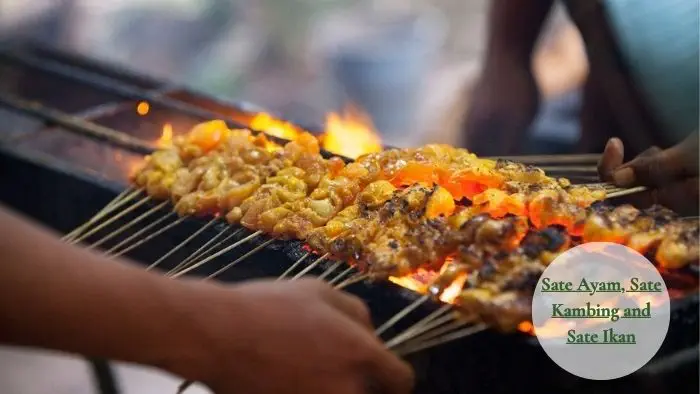
Mepanggang / Nyate – the art of Balinese grilling, creating smoky and “delicious” dishes like Sate Lilit, a must-try Bali food.6. Ngelawar (The Communal Art of Crafting Lawar – A Balinese Salad Tradition)
Lawar is one of Bali’s most iconic communal dishes, a vibrant and complex mixture of finely chopped vegetables (like long beans or young jackfruit), grated coconut, rich Balinese spices, and minced meat (pork or chicken are common, though plant-based Balinese cooking versions also exist using ingredients like young jackfruit or banana blossom).
Ngelawar is the intricate Balinese culinary technique of preparing and meticulously hand-mixing all these components. It’s a true labor of love, often undertaken together by men in the community (gotong royong) for ceremonies and celebrations. This process requires a keen sense of flavor balance and achieving the perfect textural harmony, making Lawar a unique Balinese salad tradition.
7. Mengukus / Ngekukus (Steaming – Gentle & Flavorful Moisture in Bali Cooking)
Steaming (mengukus or ngekukus) is a wonderfully gentle Balinese cooking method that beautifully preserves the moisture, nutrients, and delicate flavors of ingredients. In Bali, food is often steamed in banana leaf parcels, known as tum or pepes. This isn’t just practical; the banana leaf also infuses the food with a subtle, sweet, and earthy fragrance.
From savory fish or chicken tum (like the popular Tum Ayam – steamed spiced chicken) and brengkes (another term for leaf-wrapped packages, often for fish) to sweet rice cakes (jaje Bali), mengukus is a healthy, refined, and “delicious” technique for preparing many authentic Bali recipes. It’s a core part of Balinese food preparation that showcases elegance and respect for ingredients.
8. Merebus / Nglablab (Boiling & Simmering – For Hearty Balinese Soups, Stews & Broths)
Merebus (boiling) or nglablab (to boil/dissolve, often implying longer cooking for stews or to extract flavor) covers the essential Balinese cooking methods of boiling and simmering. These techniques are fundamental for creating Bali’s comforting and nourishing soups (kuah or sop) and rich stews. Whether it’s a clear, fragrant broth infused with fresh herbs (like the unique Jukut Ares – banana stem soup, or the tangy Gerang Asem – sour and spicy soup), or a slow-simmered curry where flavors deepen and meld over time, this technique is vital to many beloved Balinese recipes such as kekomoh (a rich, brothy dish typically made with offal).
Beyond the Basics: Unique & Ancient Balinese Cooking Methods – A Glimpse into Bali’s Culinary Past
Bali’s culinary repertoire also includes some truly unique and ancient cooking methods, often reserved for special occasions or showcasing particular regional Balinese specialties. These traditional approaches offer a fascinating glimpse into the island’s rich culinary history and resourcefulness:
9. Betutu Method (Ultra Slow Cooking in Earth or Husks):
This legendary Balinese cooking technique involves stuffing a whole chicken (Ayam Betutu) or duck (Bebek Betutu) with a rich Base Genep spice paste. The bird is then wrapped tightly in multiple layers of banana leaves and traditionally in areca palm bark (upih or pelepah pinang) to seal in all the juices and aromas. The most ancient method, metambus, involves slow-cooking this package for many hours (sometimes up to 12 hours or more!) buried in smoldering rice husks (sekam padi) or a pit in the earth with hot coals. The result is incredibly tender, succulent, aromatic, and deeply flavorful meat that literally falls off the bone – a true “must-try Balinese food” and a testament to the art of slow cooking.
10. Timbungan (Cooking in Bamboo Tubes):
This ancient Balinese food preparation technique involves cooking food (often fish, chicken, or pork, richly seasoned with spices and sometimes coconut milk) inside a segment of young, green bamboo tube (bumbung or belong). The bamboo tube is sealed, often with banana leaves, and then placed over or near an open fire or hot embers, slowly cooking the contents within. The bamboo acts as a natural cooking vessel and steamer, imparting a unique, subtle earthy and smoky flavor while keeping the food exceptionally moist and tender. Bebek Timbungan (duck cooked in bamboo) is a celebrated example of this traditional Balinese method.
11. Nyat-Nyat ( simmering a dish with a flavorful spice paste until the liquid reduces and thickens):
A distinct and highly valued technique related to this is Nyatnyat. This is a specific Balinese cooking method that involves simmering ingredients, often with a rich bumbu, until the cooking liquid (water or coconut milk) significantly reduces and thickens, intensely coating the main ingredients. The word “nyat” itself means to shrink or reduce. This process concentrates the flavors beautifully, creating a rich, almost dry stew where the spices cling to every morsel. A famous example is Mujair Nyatnyat (tilapia cooked in this intensely flavored, reduced sauce).
While these methods are more complex and time-consuming, understanding them offers a deeper appreciation for the ingenuity, patience, and dedication involved in preparing ceremonial Balinese dishes and preserving ancient Bali cooking traditions.
The Magic of Banana Leaves & Other Natural Wrappers: Bali’s Eco-Friendly Cookware
You’ll quickly notice that banana leaves (daun pisang) are indispensable in traditional Balinese kitchens, far more than just a pretty garnish! They are a functional, sustainable, and wonderfully aromatic Balinese cooking tool, central to many authentic Bali recipes.
Used for wrapping food for steaming (tum), grilling (pepes), or roasting, banana leaves (after being briefly wilted over a flame to make them pliable) impart a subtle, sweet, and earthy fragrance to the food. Crucially, they help keep food incredibly moist by trapping steam during the cooking process. They also serve as natural, biodegradable plates (pincuk) or liners for serving food, especially for takeaway meals or during ceremonies.
It’s a perfect example of Bali’s deep connection to its natural environment and its resourceful, eco-conscious culinary traditions, a core part of the Balinese sustainable approach.
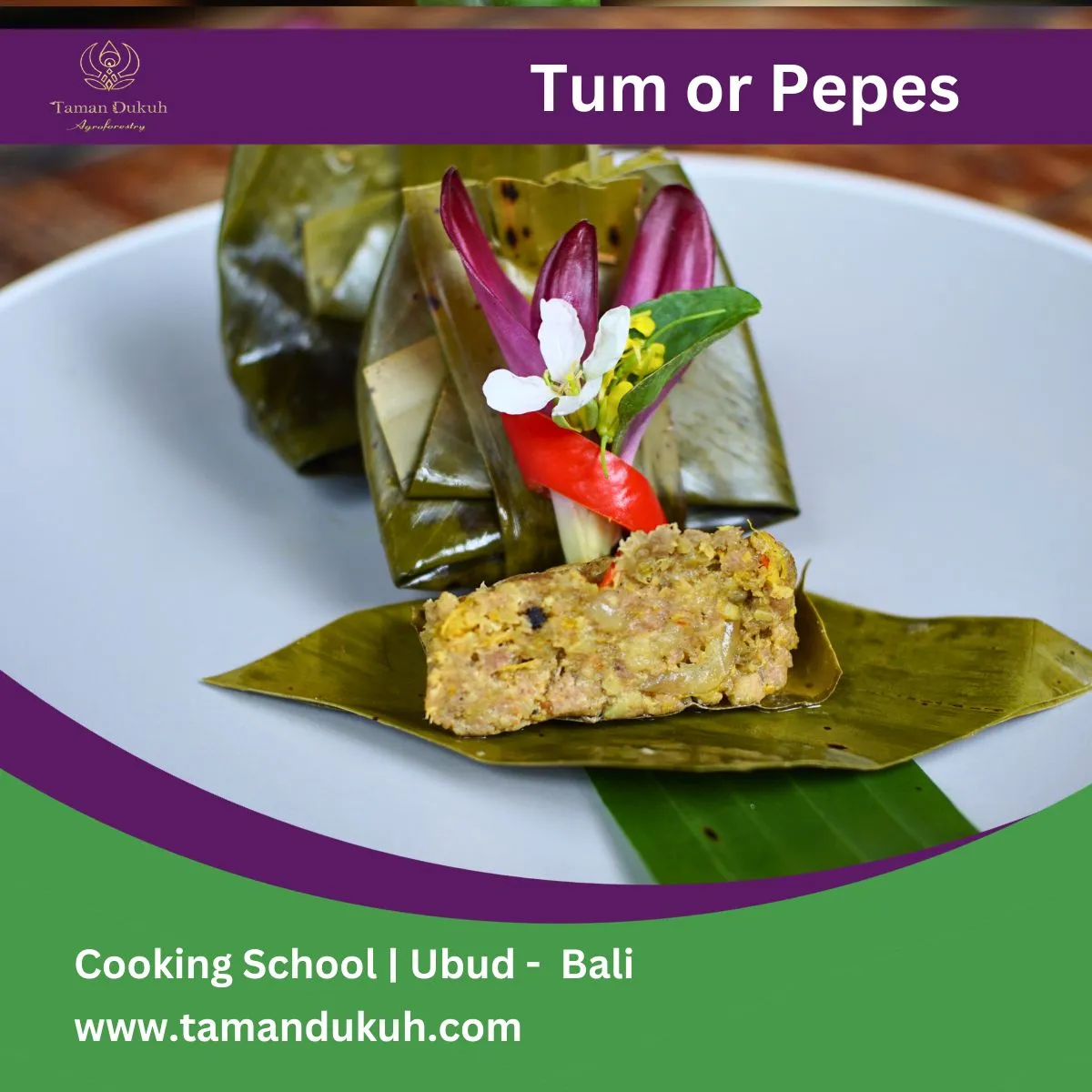
Experience the Joy & Art of Balinese Cooking with Our Expert Chefs in Ubud!
Learning these traditional Balinese cooking techniques is so much more than just following instructions from a recipe book; it’s about feeling the rhythm of the Balinese kitchen, understanding how flavors build and harmonize, and having a “super fun” and “engaging” time doing it!
Our “friendly, funny, and passionate” Balinese cooking instructors at Taman Dukuh are dedicated to making these authentic methods accessible and enjoyable for everyone, “whether you call yourself a cook or not.” They share not just the ‘how’ of Balinese food preparation, but also the ‘why,’ connecting each technique to the culture, stories, and traditions behind the dishes.
We believe that the best way to truly appreciate these methods is to try them yourself, guided by local experts in our “gorgeous Ubud farm setting.” You’ll leave not only with new skills to impress your friends and family with your Balinese culinary prowess but also with “unforgettable memories” and the confidence to recreate these “tasty and spectacular” Balinese dishes at home.
Or join one of our hands-on cooking classes!

